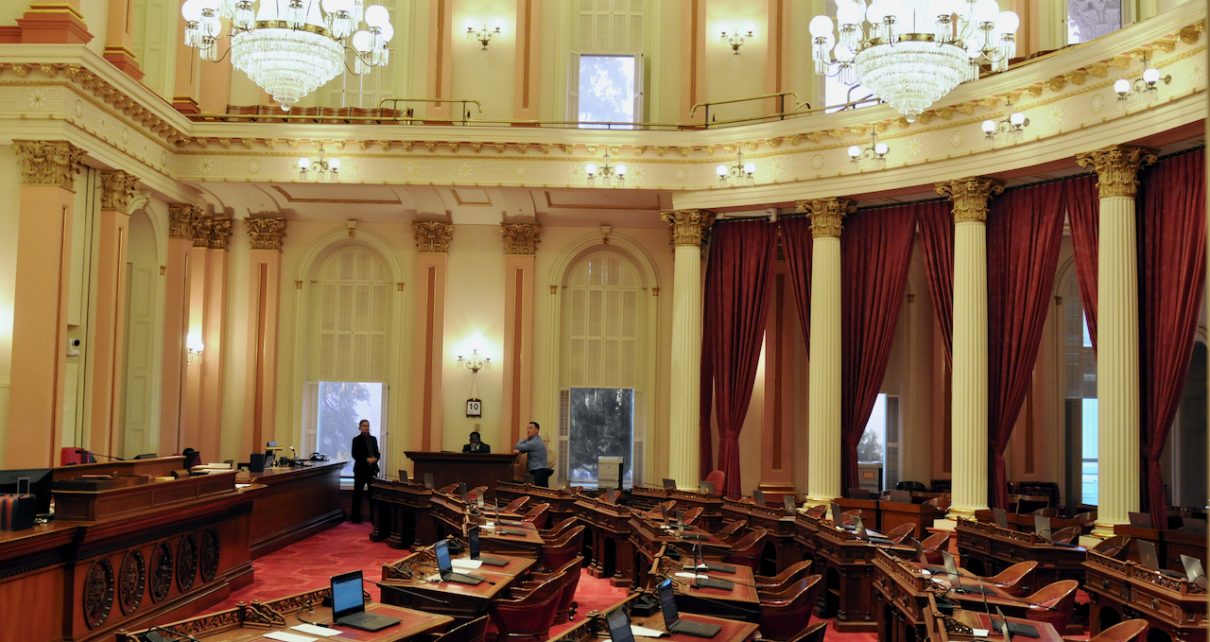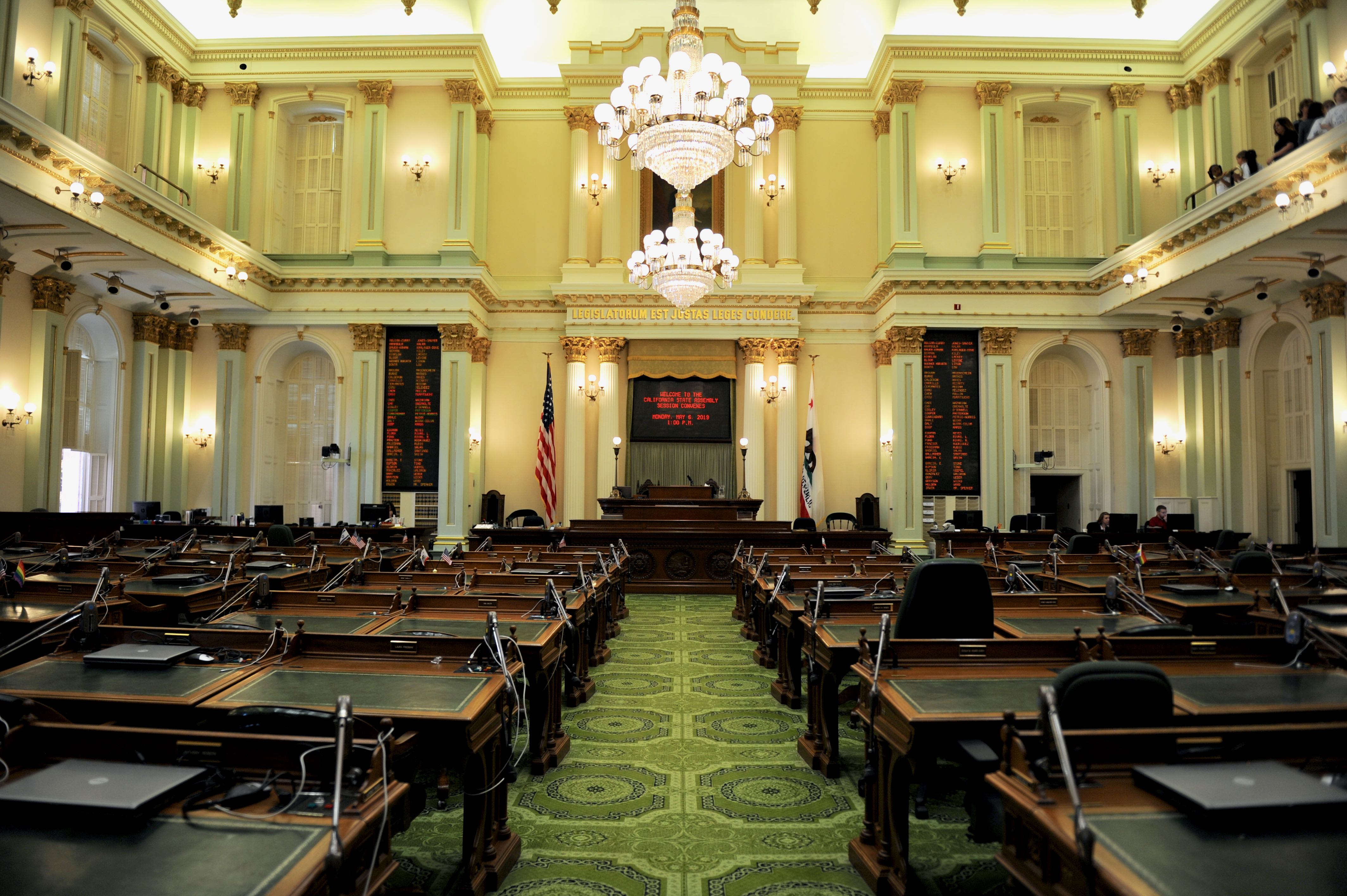
California Senate Chambers. (Photo: Kevin Sanders for California Globe)
A Sampling of Differences in the Legislative Process between the Assembly and Senate
What are some key differences in the legislative process between the two houses of the Legislature?
By Chris Micheli, July 20, 2021 2:10 am
There are a number of differences between the Assembly and the Senate in terms of the California legislative process, many of which are minor in nature. However, for students of the process, as well as those involved in the State Capitol, there are some interesting differences. Essentially, the two houses follow similar rules because they basically have the same roles in the legislative process. Nonetheless, there are several differences of note. The following is not an exhaustive list, but highlights some key differences in the legislative process between the two houses of the Legislature.
Leadership
The Senate is led by the President pro tempore and the Rules Committee, whereas the Assembly is led by the Speaker. In the Senate, the Rules Committee generally has the same powers as the Speaker does in the Assembly.
Confirmation of Appointees
The Senate confirms specified gubernatorial appointments. In the Assembly, this role is limited to the confirmation of nominees to fill a vacancy for a constitutional office.
Members’ Office Budgets
Senate offices are given a fixed number of staff positions that they can fill and a small budget allocation; on the other hand, Assembly offices are given an office budget from which they pay staff salaries and expenses. The Senate also uses a structure for salaries with steps and ranges for each position.
Jurisdiction of Policy Committees
Many committees are the same between the two houses, both in name and in subject matter jurisdiction. However, there are a few differences. For example, in the Assembly, worker’s compensation bills go to the Insurance Committee; however, in the Senate, they go to the Labor, Public Employment & Retirement Committee. The Assembly has 32 committees, while the Senate has 22 committees.
Appropriations Committees
Senate Appropriations Committee allows support and opposition testimony at hearings even where the author waives presentation. The Assembly generally does not. It usually announces all of the bills going to suspense and accepts brief testimony at the end. The Assembly presume an author’s presentation is waived if the bill is going to suspense. The Senate requires a letter from the author to the committee waiving presentation for suspense file bills.
Regarding their suspense files, the Assembly committee goes through bills by subject matter, while the Senate committee goes through bills by author. In addition, the Assembly votes to pass or announces which bills are held on suspense, while the Senate only votes on bills it will pass off of the suspense file.
Waiver of Fiscal Hearing on Bills
The Senate has Rule 28.8, which allows the Appropriations Committee Chair to place a bill on the second reading file without a committee vote if the Chair deems the bill to not have significant state fiscal impact. The Assembly Appropriations Committee has no such rule, but does try to utilize its consent calendar in a similar manner to SR 28.8.
Meetings of Budget Subcommittees
All of the Senate subcommittees meet at the same time on Thursday morning overlapping with rare exception, while the Assembly subcommittees meet on different days and times with almost no overlap (during non-pandemic times).
In recent years, the Senate Budget & Fiscal Review Committee hears and votes on the budget bills and trailer bills, while the Assembly Budget Committee generally conducts informational hearings on the budget and trailer bills and then sends them to the floor without a formal vote.
Jurisdiction of Budget Subcommittees
The budget subcommittees have the following subject matter jurisdictions:
Education (Senate Subcmte #1 and Assembly Subcmte #2)
Resources, Environment, and Transportation (Senate Subcmte #2 and Assembly Subcmte #3)
Health and Human Services (Senate Subcmte #3 and Assembly Subcmte #1)
State Government (Senate Subcmte #4 and Assembly Subcmte #4)
Public Safety and Judiciary (Senate Subcmte #5 and Assembly Subcmte #5)
Bill Introductions
The Assembly allows a maximum of 50 bills to be introduced by each member during a 2-year session, while the Senate allows a maximum of 40 bills to be introduced by its members during the same period of time.
Bill Referrals
The Senate does not refer bills that only call for studies or reports. The Assembly does refer such measures to committee. As a general policy, the Assembly Rules Committee does not hear resolutions weighing in on matters of foreign policy. The Senate has no such limitation.
Amendment Deadlines
The Assembly requires amendments to be submitted by 5 pm or the close of session the day before a deadline. The Senate does not have the same rule.
30-Day in Print Rule
The Assembly has a different interpretation of the 30-day wait period contained in Art IV. Sec 8(a) of the Constitution than the Senate. Once a bill has been referred to committee, the Assembly permits pre-committee author’s amends to bills within the 30-day period, while the Senate does not.
Spot Bills
The Assembly imposes a deadline for amendments to spot bills in order for those bills to be referred to committee. The Senate does not have such a rule, but does have a formal policy.
Floor Voting
The Senate records votes by voice vote, while the Assembly records votes electronically
The Assembly allows its members to add or change votes after the vote has been announced, so long as the final vote is not impacted. The Senate does not allow that, except for the President pro Tempore and the Minority Leader. So, on the Assembly Floor, members are allowed to add on or change their vote for up to about 15 minutes after adjournment so long as it does not change the outcome on the bill.
Tie Votes
The Lt. Governor is the President of the Senate, which is primarily a ceremonial role, except in the case of a tie vote. The Lt. Governor can break such a tie. In the Assembly, the motion or bill fails in the case of a tie vote.
Floor Analyses
The Senate floor analyses list support and opposition positions, but the Assembly does not list any positions on their floor analyses.
Staff on the Floors
Assembly or Senate staff can go onto the Senate Floor with their ID, not a “pass” (during non-pandemic times). In the Assembly, a floor pass from the Speaker is needed.
Inactive Files
Bills taken off of the Senate Inactive File are returned to second reading. In the Assembly, bills previously on Third Reading that are moved to the Inactive File are subject to a “one-calendar-day notice” when removed from the Inactive File and returned to Third Reading.
Motions
In the Assembly, there must be a second to a motion. In the Senate, there is no need to second a motion for bills in committee. So, in the Senate, only a motion is required.
Standards of Conduct
The Senate has written Standards of Official Conduct, but the Assembly does not.
Committee Bills
The Assembly requires a majority of the committee members to author the bill; Senate requires all members of the committee to sign onto the bill
- Exemptions from Tax Withholding in California - July 23, 2024
- General Provisions of California’s Evidence Code - July 22, 2024
- Judicial Notice Under the California Evidence Code - July 21, 2024





Chris, instead of a sanitized 10th-grader tour of the Assembly and Senate, let’s get into the nitty gritty. That is, the how and why of the Third House; it’s membership, relationships, purpose and so forth. As a lobbyist, you should be an expert in it’s inner workings. As for the article, I suggest that you keep this kind of condescending crap confined to your academic classroom. As grownups, we don’t need it here; we have other priorities:
“California’s Capitol is not truly run by elected representatives, but by what’s known as the “Third House.” That’s the term for a corps of Special Interest lobbyists, with offices encircling the Capitol, that accounts for the vast majority of political funding in California. It’s called the Third House because these lobbyists control the first two houses, the Assembly and Senate. And they certainly control the Governor.” – Recall Newsom (Kiley, 2021) page 20. (RecallNewsomBook.com)
The California Globe has a vast audience with different levels of knowledge.
I for one appreciate the very succinct summary of how government runs at the state level.
For those who are more attune do not have to read such articles.
I do appreciate the add of the the “third house” and readers who are not familiar should research. One hint, Newsom likes to dine and wine taste with the “Third House”.